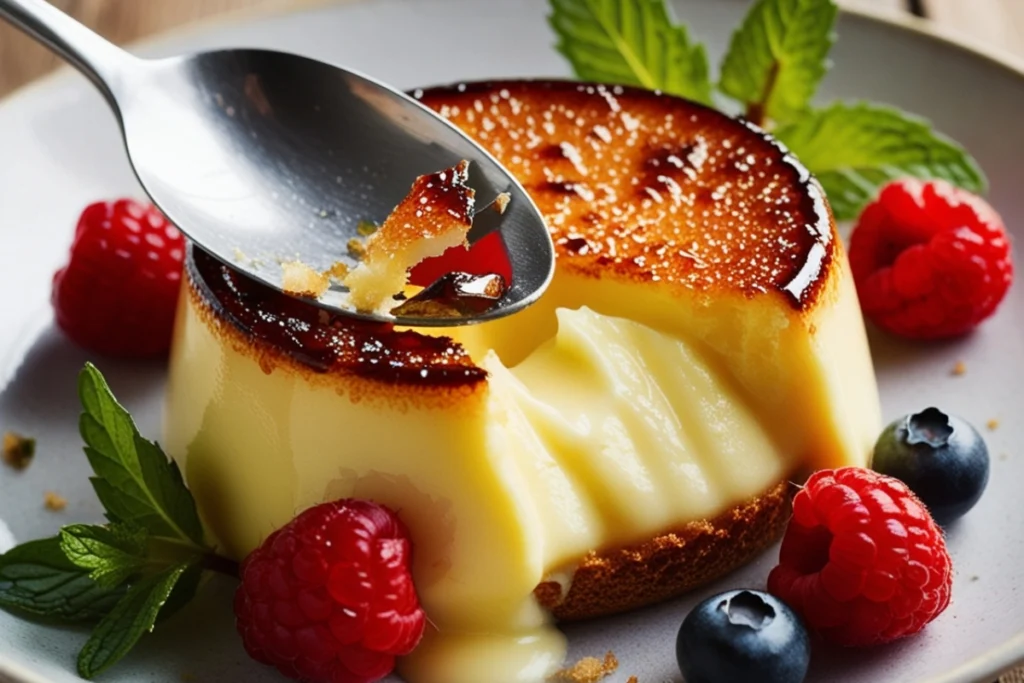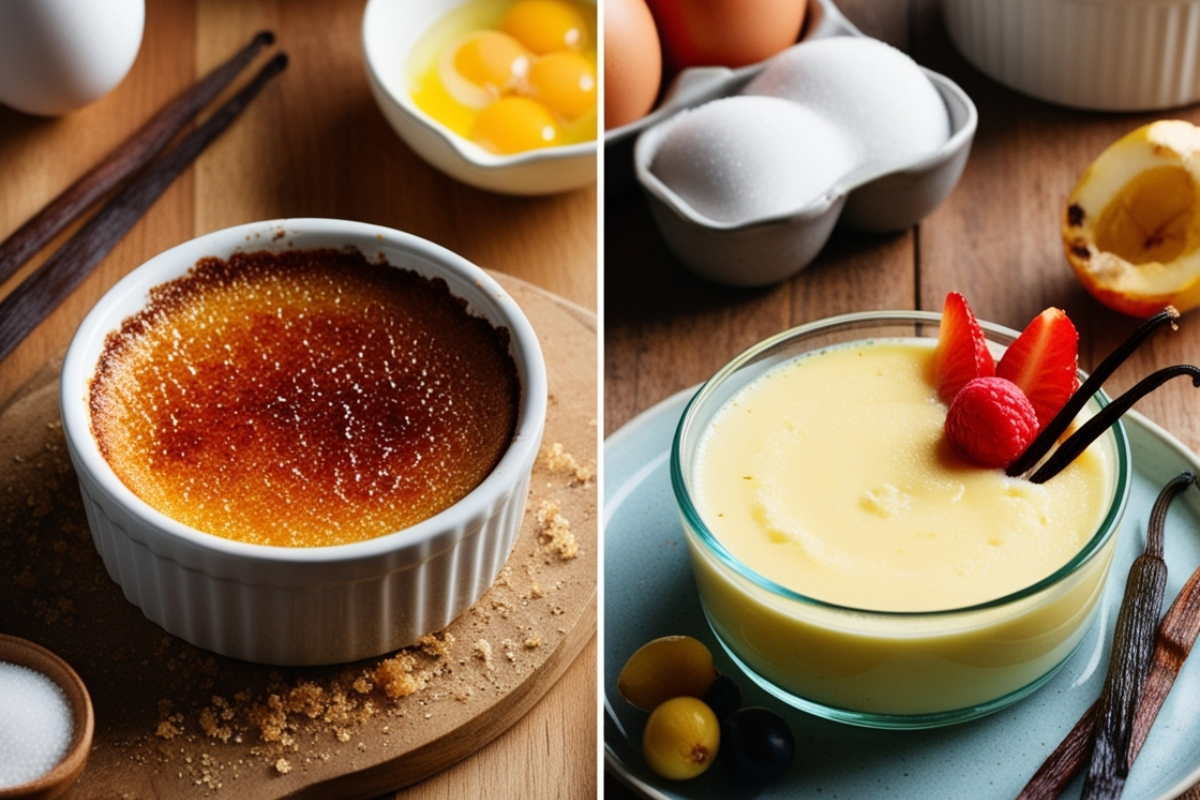Exploring the nuances between crème brûlée and custard takes you on a delightful journey through the world of desserts. While both share a creamy base, they stand apart in their preparation, texture, and presentation. In this article, we’ll uncover what makes each dessert unique, examining their ingredients, cooking techniques, and cultural significance. By the end, you’ll have a deeper appreciation for these classic treats and their irresistible charm. Let’s dive into their origins and begin this sweet adventure!
Jump ahead to:
What is Custard?
Definition and Basic Ingredients
Custard is a beloved dessert made from a creamy blend of milk, eggs, and sugar. Flavors like vanilla or citrus zest often enhance its sweetness and aroma. Its versatility shines in its ability to adapt—ranging from soft and pourable sauces to firm, sliceable creations, depending on the recipe. Eggs, the key ingredient, play a vital role by thickening the mixture and creating a smooth, melt-in-your-mouth texture that makes custard so irresistible.
History and Cultural Significance of Custard
Custard has a long history that goes back to the Middle Ages, when it was first popular as a filling for tarts. Over time, it changed into its own unique dessert, inspiring many recipes across Europe, Asia, and beyond. For example, in France, the smooth crème anglaise became a loved sauce, while in Latin America, the caramel-topped flan became a popular treat. Its simplicity and flexibility have also helped custard succeed in both sweet and savory dishes. Because of this, it continues to bring comfort and joy to kitchens around the world.
What is Crème Brûlée?
Definition and Unique Features
Crème brûlée, translating to “burnt cream” in French, is a decadent dessert that pairs a velvety custard base with a crispy caramelized sugar topping. Made with heavy cream, egg yolks, sugar, and vanilla, it’s baked until just set, then finished with a torch to create its signature crackly crust. This textural contrast—smooth custard beneath a crunchy sugar layer—is what sets crème brûlée apart from its custard cousins.
Historical Background of Crème Brûlée
This iconic dessert has deep roots in French culinary traditions, although its exact origins remain a topic of debate. For instance, some historians believe it first appeared in a French cookbook published in 1691, while others suggest it may have Spanish or British influences. Despite these uncertainties, crème brûlée has become a symbol of sophistication and elegance, frequently appearing on the menus of fine dining restaurants around the world.
The Connection Between Crème Brûlée and Custard
Shared Ingredients
Both desserts rely mainly on cream, eggs, and sugar to create their signature creamy bases. Because of this shared reliance on these simple yet rich ingredients, they share a common foundation. As a result, crème brûlée is considered a subset of custard desserts.
Why They’re Often Compared
While crème brûlée is technically a custard, the addition of its caramelized sugar topping and use of heavy cream instead of milk give it a distinct identity. Their differences in texture, preparation, and final presentation often spark debates among dessert enthusiasts, making the comparison both inevitable and fascinating.
Comparing Ingredients in Crème Brûlée and Custard
Differences in Dairy Base: Cream vs. Milk
The type of dairy used is one of the primary differences between crème brûlée and custard. Traditional custard recipes often call for milk, which creates a lighter consistency. In contrast, crème brûlée relies on heavy cream, lending it a richer, silkier texture that feels more indulgent. The choice of dairy impacts not only the texture but also the dessert’s overall mouthfeel, making crème brûlée denser and custard more delicate.
Role of Eggs and Sweeteners in Texture and Flavor
Eggs play a pivotal role in both desserts. Custards typically use whole eggs, which create a firmer set, while crème brûlée uses only the yolks, adding to its luscious creaminess. Sweeteners also vary, with custard recipes sometimes incorporating alternative sugars like honey or maple syrup for unique flavor profiles, whereas crème brûlée traditionally uses granulated sugar for its characteristic caramel topping.
Preparation Techniques
Cooking Methods: Baking, Steaming, or Stovetop
Custards are incredibly versatile in preparation methods. They can be baked in an oven, steamed on a stovetop, or even thickened directly in a saucepan. Crème brûlée, on the other hand, is almost exclusively baked in a water bath, which helps maintain its silky texture by ensuring gentle, even heat distribution.
The Signature Caramelized Sugar Layer of Crème Brûlée
What truly sets crème brûlée apart is its caramelized sugar crust. This topping is created by sprinkling granulated sugar evenly over the set custard and using a kitchen torch to melt it into a crispy layer. This process not only enhances the dessert’s visual appeal but also provides a delightful textural contrast with each spoonful.
Crème Brûlée Recipe
Ingredients
- 2 cups heavy cream
- 5 large egg yolks
- ½ cup granulated sugar (plus extra for caramelizing)
- 1 teaspoon pure vanilla extract
- A pinch of salt
Step-by-Step Cooking Instructions
1. Prepare the Custard Base:
- Preheat your oven to 325°F (160°C).
- In a medium saucepan, heat the heavy cream over medium heat until it begins to simmer. Avoid boiling.
- While the cream is heating, whisk together the egg yolks, sugar, vanilla extract, and salt in a mixing bowl until smooth.
2. Temper the Egg Mixture:
- Slowly pour a small amount of the heated cream into the egg mixture, whisking constantly to prevent curdling.
- Gradually add the remaining cream, whisking until fully combined.
3. Bake in a Water Bath:
- Strain the custard mixture through a fine-mesh sieve to remove any lumps.
- Pour the custard into ramekins, filling them about ¾ full.
- Place the ramekins in a deep baking dish and pour hot water into the dish until it reaches halfway up the sides of the ramekins.
- Bake for 30–35 minutes, or until the custards are set but still slightly jiggly in the center.
4. Chill and Caramelize:
- Remove the ramekins from the water bath and allow them to cool to room temperature.
- Cover and refrigerate for at least 4 hours or overnight.
- Before serving, sprinkle a thin, even layer of granulated sugar on top of each custard.
- Use a kitchen torch to caramelize the sugar until golden brown and crisp. Let cool for a minute before serving.
Nutritional Information (Per 100g)
| Nutrient | Amount |
|---|---|
| Calories | 210 kcal |
| Protein | 3.5 g |
| Fat | 18 g |
| Saturated Fat | 11 g |
| Carbohydrates | 11 g |
| Sugar | 10 g |
| Sodium | 25 mg |
Texture and Consistency
Crème Brûlée’s Creamy Base with a Crisp Topping

Crème brûlée offers a luxurious textural contrast that’s hard to resist. Beneath its caramelized sugar crust lies a rich, velvety custard base made from heavy cream and egg yolks. The creamy interior provides a decadent mouthfeel, while the sugar crust adds a satisfying crunch. The combination of smooth and crisp textures creates a dessert that feels indulgent yet balanced. Each bite offers a delightful interplay of softness and crackling caramel, making it a sensory masterpiece.
Custard’s Range: Pourable to Firm Set
Custard, on the other hand, boasts a wide range of textures depending on the recipe. It can be light and pourable, like crème anglaise, which is often used as a sauce for desserts. Alternatively, custard can be firm and sliceable, as seen in flans or pies. This versatility makes custard a go-to base for countless dishes, from decadent trifles to savory quiches. Regardless of its form, custard maintains a smooth, creamy consistency, making it universally appealing.
Presentation and Serving Styles
Ramekins and Traditional Dishes
The choice of serving vessel plays a significant role in how both desserts are presented. Crème brûlée is traditionally served in individual ramekins, which allow for even baking and an elegant presentation. The shallow, wide ramekin also maximizes the caramelized sugar surface, enhancing the visual and textural appeal. Meanwhile, custard is more flexible in its presentation. It can be served in deep bowls, shallow dishes, or even as part of layered desserts like trifles, making it a versatile crowd-pleaser.
Garnishes, Flavor Infusions, and Plating
Both crème brûlée and custard are enhanced by thoughtful garnishes and flavor infusions that make their presentation even more appealing. For example, crème brûlée is often topped with fresh fruits, like berries or citrus slices, which add a refreshing contrast to its rich creaminess. Similarly, custards can be infused with flavors such as vanilla bean, cardamom, or matcha to provide an exciting twist, whether they are sweet or savory. Additionally, a drizzle of sauce or a light dusting of powdered sugar can instantly elevate the look of these desserts. With these simple touches, both crème brûlée and custard can transform into stunning culinary creations, perfect for any occasion.
Custard Around the World
Popular Custard Desserts in Global Cuisines
Custard’s global popularity is evident in the many iconic desserts it inspires. In Latin America, the caramel-topped flan is a household favorite, known for its smooth texture and rich caramel sauce. The UK celebrates custard tarts, a classic treat with a creamy egg filling and buttery crust. Over in Asia, silky egg tarts are a dim sum staple, enjoyed for their delicate balance of sweetness and flakiness. Even in India, rabri, a condensed milk dessert flavored with cardamom and saffron, highlights how custard-like textures captivate palates worldwide.
Savory Custards and Their Unique Applications
While sweet custards are widely beloved, their savory counterparts hold an equally prominent place in global cuisines. French quiches, made with a savory custard base of cream and eggs, are versatile and satisfying. Japan’s chawanmushi, a steamed egg custard, is a light and flavorful dish often enriched with seafood and mushrooms. In the culinary world, savory custards also appear as accompaniments, such as in soufflés or as the base for creamy sauces like béchamel. These adaptations demonstrate custard’s remarkable versatility in both sweet and savory forms.
Crème Brûlée’s Prestige in Fine Dining
Status as a Luxury Dessert
Crème brûlée holds a distinct place as a symbol of indulgence and sophistication. With its rich cream base and labor-intensive caramelized sugar topping, it has become a staple of high-end restaurant menus. The simple yet elegant nature of crème brûlée allows it to stand out, often reserved for celebrations and special occasions. Its preparation, requiring precision and flair, adds to its allure as a dessert that embodies luxury.
Modern Twists on Classic Crème Brûlée
While the classic vanilla crème brûlée remains timeless, chefs worldwide have embraced innovation by infusing it with bold and modern flavors. Matcha, lavender, chai spice, and even tropical fruits like passion fruit have given this classic dessert a contemporary twist. Beyond flavor, some chefs experiment with plating, layering crème brûlée with fruits or chocolate to add depth and visual appeal. These creative reinterpretations keep the dessert relevant and exciting while honoring its traditional roots.
FAQs About Crème Brûlée and Custard
Is Crème Brûlée a Type of Custard?
Yes, crème brûlée is a type of custard. More specifically, it is part of the baked custard family, made by combining eggs, cream, and sugar. Chefs cook this mixture gently, often using a water bath, to create a rich and creamy texture while keeping it smooth. What makes crème brûlée stand out is its caramelized sugar crust. This crunchy topping contrasts beautifully with the soft custard below, giving the dessert its unique character. Although crème brûlée shares many features with other custards, its crisp sugar layer truly sets it apart.
What’s the Main Difference Between Crème Brûlée and Custard?
The main difference between crème brûlée and custard comes down to how they are made and served. Custard is a broad category of desserts with a variety of textures, ranging from pourable sauces to firm baked dishes like flan. On the other hand, crème brûlée is always a baked custard that includes a caramelized sugar topping. In addition, custards typically use milk, while crème brûlée is made with heavy cream, which gives it a richer and thicker texture. These differences in ingredients and preparation methods make crème brûlée stand out, even though it is still a part of the custard family.
Which is Easier to Make: Crème Brûlée or Custard?
Custard is easier to make because it has fewer steps and uses simpler techniques. For instance, you can thicken custard on the stovetop, which makes the process faster and less complicated. Some baked custards, like flan or pies, only require mixing the ingredients and then baking them. In contrast, crème brûlée needs more precision. Its preparation includes baking the custard in a water bath to avoid curdling, followed by creating a caramelized sugar topping. Making the topping takes extra care and skill, whether you use a torch or a broiler. Because of these differences, custard is more beginner-friendly, while crème brûlée offers a greater challenge for cooks who want to master its advanced techniques.
Is Crème Brûlée Served Warm or Cold?
Crème brûlée is usually served cold, but the sugar topping is warmed right before it is served. This mix of cool custard and a freshly caramelized sugar layer creates an interesting contrast. After baking, chefs refrigerate the custard to let it chill and set fully. Just before serving, they torch the sugar topping to make sure it stays crisp and fresh. This careful balance of temperatures and textures makes crème brûlée a dessert that is both special and satisfying.
What Is the Secret of Crème Brûlée?
The secret to crème brûlée is in balancing a smooth custard base with a crispy sugar topping. To get the best flavor and texture, it is important to use fresh ingredients, like high-quality cream and eggs. Baking the custard gently in a water bath helps keep it creamy and smooth while also preventing cracks from forming. For the sugar topping, an even sprinkle followed by careful torching creates the dessert’s signature crunch. By focusing on each step—mixing, baking, and torching—you can make sure this dessert turns out just right every time.
For more delicious and easy recipes, Discover More Recipes.


1 thought on “What’s the Difference Between Crème Brûlée and Custard?”